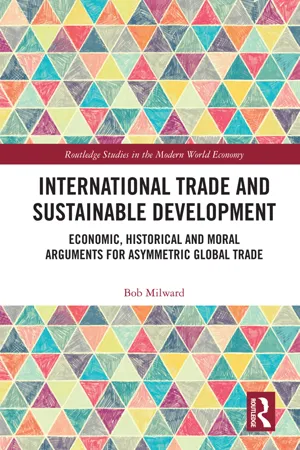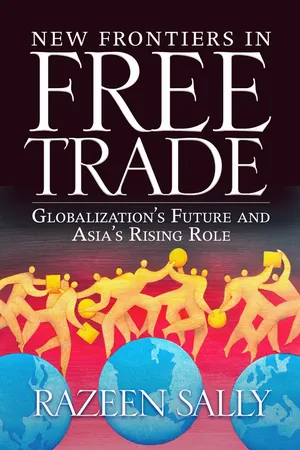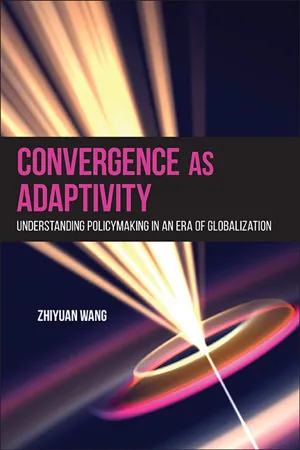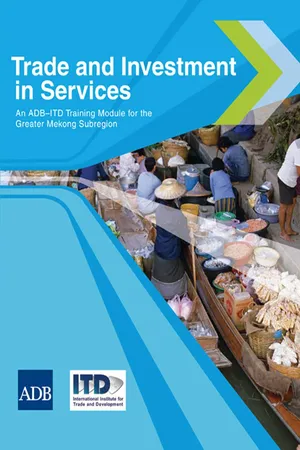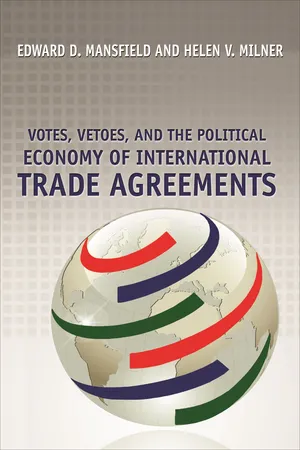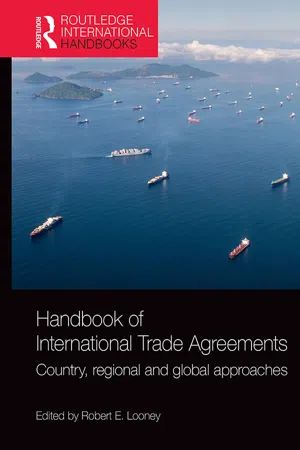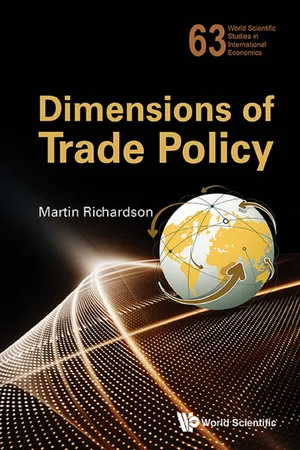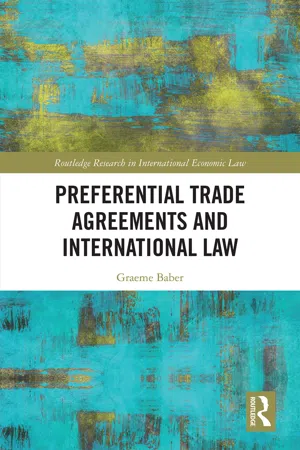Economics
Preferential Trade Agreements
Preferential Trade Agreements (PTAs) are trade deals between countries that reduce tariffs and other trade barriers for certain goods and services. PTAs are designed to promote trade and economic cooperation among member countries. They can lead to increased market access and trade expansion, but may also create trade diversion and complicate global trade negotiations.
Written by Perlego with AI-assistance
Related key terms
Related key terms
1 of 4
Related key terms
1 of 3
10 Key excerpts on "Preferential Trade Agreements"
- eBook - ePub
International Trade and Sustainable Development
Economic, Historical and Moral Arguments for Asymmetric Global Trade
- Bob Milward(Author)
- 2019(Publication Date)
- Routledge(Publisher)
4 that have been in force in each year since 2004 more than doubled from less than 120 in 2004 to more than 250 in 2014. This upward trend is likely to continue as additional PTAs are still in the negotiation phase and likely to be implemented in the next few years. About half of all trade agreements in force go beyond tariff concessions, to cover services and behind the border measures. Although the number of PTAs has increased dramatically, the percentage of trade taking place under PTAs has not increased as much. Still, even without considering intra-EU trade, about 30 percent of world trade took place in 2014. Another 15 per cent of world trade was covered by trade agreements limited to preferential access, and about 7 per cent was under unilateral preferences such as the ones provided by developed countries to least developed countries. [UNCTAD, 2015:14] In their study, Tobin and Busch find evidence to support the argument that BITs make the likelihood of North-South PTAs greater up to a point. The attractiveness of BITs for underdeveloped economies is to be found in the offsetting of the risk of uncompensated expropriation demanded by the Multinational Corporations. Demonstrable reduction in risk then makes it more likely that the more complex and costlier PTA can be negotiated. [Tobin & Busch, 2010:30]During the past fifty years an increasing number of advanced developed economies have offered preferential access for a wide range of goods produced in underdeveloped countries through non-reciprocal preferential trading agreements (NRPTAs). [Gil-Pareja et al., 2017:143] Indeed, some commentators have argued that Preferential Trade Agreements (PTAs) have become the predominant form of international trade liberalisation in recent decades, although the efficiency of such trading arrangements has thus far not been established with any certainty. [Spilker et al., 2018:189] According to Baccini and Dür, the number of notified PTAs has grown in parallel with the growth in Foreign Direct Investment and that this represents the very rapid growth in both. Between 1990 and 2007 there were 247 new free trade agreements that incorporated preferential trade links – in 1990 245 agreements had a preferential trade relationship and by 2007 there had been a 750% increase to 2,123. [Baccini & Dür, 2015:619] This rapid increase in PTAs has been ascribed to the continued breakdown of talks at the Doha round of trade negotiations which commenced in November 2001, with the objective of lowering barriers around the world. [Dieter, 2009:393] It is further suggested that the global economic and financial crisis of 2007/08 further reduced the willingness of policy makers to support formal trade liberalisation on a global scale. [Ibid] Most of the early increase in PTAs has been ascribed to developed economies in relatively close geographical proximity, especially those involving European countries. However, in recent years, increasingly it has been countries outside the continent of Europe and geographically distant pairs of economies that have participated in what has been described as a ‘wave of preferentialism’ in global trade. [Baccini & Dür, 2015:619] - eBook - ePub
New Frontiers in Free Trade
Globalization's Future and Asia's Rising Role
- Razeen Sally(Author)
- 2008(Publication Date)
- Cato Institute(Publisher)
5. Preferential Trade Agreements
We will work with can-do, not won’t-do, countries. —Robert Zoellick All hat and no cattle. —Texan sayingGiven the parlous state of the World Trade Organization, it is not surprising that governments all over the world have turned to bilateral and regional negotiations to conclude preferential (i.e., discriminatory) trade agreements. These, it is said, can move faster, wider, deeper than multilateral negotiations. Thus, venting his spleen after the WTO’s failed Cancu´n Ministerial Conference, Bob Zoellick, the U.S. special trade representative, promised to speed ahead with bilateral deals with willing ‘‘can-do’’ partners. Skeptics, however, say that Preferential Trade Agreements (PTAs) are not what they are cracked up to be. And cynics would echo the Texanism quoted above.Do PTAs facilitate regional economic integration and, by extension, global economic integration? How credible are negotiating positions, the choice of negotiating partners, and the agreements already in operation? How good or bad is the fit between PTAs and economic policy at home? And how do they relate to involvement in the WTO? Take a look first at general trends, and then at PTAs in Asia, the scene of the most feverish PTA activity in recent years.Building Blocs and Stumbling Blocs
By July 2005, 330 PTAs had been notified to the General Agreement on Tariffs and Trade/WTO—206 of them since the establishment of the WTO in 1995 (Figure 5.1). More than 180 are in force, with many more expected to be operational soon. Of the PTAs in force, 84 percent are free trade agreements (FTAs), with customs unions and partial-scope agreements making up the rest.1 Bilateral (countryto-country) agreements account for over 75 percent of PTAs in force and almost 90 percent of those under negotiation. PTA activity has increased pace since 1999–2000, and even more so since the launch of the Doha round.2Many regions have long been involved in PTAs. For the European Union, this goes back to its beginnings in the European Coal and Steel Community and then the European Economic Community. In North America, it took off with the U.S.-Canada FTA in the late 1980s. Africa, Latin America, and south Asia got going in the 1960s, and eastern Europe and the ex–Soviet Union after the end of the cold war. - eBook - ePub
Convergence as Adaptivity
Understanding Policymaking in an Era of Globalization
- Zhiyuan Wang(Author)
- 2023(Publication Date)
- SUNY Press(Publisher)
PTAs generate considerable economic gains. First, they promote trade between members. They can do so because PTAs grant preferential tariffs on goods from members. For example, the US-Korea Free Trade Agreement (2007) sets out to eliminate 95 percent of each party’s tariffs on goods within five years of its entering into force. This goal is hardly feasible under existing multilateral trade regimes such as the WTO, to which both the US and Korea are parties. The reduced tariffs enhance the competitiveness of one member’s goods in the other’s market. This helps to secure market access for the exporting state. By stabilizing the commitment to free trade, PTAs also suppress export volatility; in turn, this facilitates production and exports (Baccini & Dür, 2011; Behar & Cirera-i-Crivillé, 2013; Lambert & McKoy, 2009; Lee et al., 2008; Mansfield & Reinhardt, 2008). One widely cited study finds that free trade agreements approximately double bilateral trade between members 10 years after taking effect (Baier & Bergstrand, 2007). Moreover, PTAs boost FDI flows to their signatories. They do so by implementing various compliance mechanisms to generate a credible commitment to liberal economic policies (Büthe & Milner, 2008) and by increasing the size of the market through integration (Jaumotte, 2004). Such effects can be incredibly large. For example, it is estimated that PTAs among North African states can increase FDI stock by 62 percent in Algeria, 85 percent in Morocco, and 165 percent in Tunisia (Jaumotte, 2004, p. 15). Therefore, by encouraging trade and investment, PTAs can produce economic gains comparable to—if not greater than—those that lowered labor standards are intended to generate. As a result, the pressure that a state faces to reduce labor protections will be mitigated when it enters into a PTA.More importantly, PTAs’ ability to promote trade and investment can benefit workers significantly by expanding employment opportunities and boosting wages. For example, one report estimates that US free trade agreements “increased total employment by 159.3 thousand full-time equivalent employees (0.1 percent) and increased real wages by 0.3 percent in 2012” (United States International Trade Commission, 2016, p. 124). This effect is not limited to PTAs that involve developed nations. Developing-developing PTAs can generate remarkable economic gains for workers as well. For instance, according to UNCTAD’s estimation (Saygili et al., 2018), Africa will expect to see employment grow by an extraordinary 1.17 percent under a fully free trade arrangement. Clearly, workers could be better off under PTAs. - eBook - ePub
Trade and Investment in Services
An ADB–ITD Training Module for the Greater Mekong Subregion
- Pierre Sauvé(Author)
- 2009(Publication Date)
- Asian Development Bank(Publisher)
Figure 9 ). Today, few PTAs do not feature a comprehensive body of disciplines targeted at the progressive liberalization of services trade.Figure 9: On the Rise: PTAs Concluded Between 1948–2006PTA = preferential trade agreement, RTA = regional trade agreement.Source: WTO, RTA Gateway, at www.wto.org/english/tratop_e/region_e/region_e.htmGovernments’ quest for greater expediency is undoubtedly one reason for the rise of PTAs. Prodded by a private sector that increasingly views the WTO and its reliance on single undertakings and consensus-based decision making as recipes for negotiating gridlock, governments have to PTAs to achieve faster and deeper liberalization among a smaller subset of like-minded trading partners. Figure 10 offers a simple diagrammatic view of the strong presumption that PTAs can secure superior outcomes—lower levels of trade protection achieved with greater ease in a shorter time span. The figure, indeed, shows how one should expect negotiations among smaller subsets of countries to achieve deeper liberalization (i.e., a lower level of resulting protection) over shorter periods of time than that observed at the multilateral level.Figure 10: Do PTAs offer a faster route to services liberalization?GATS = General Agreement on Trade in Services, MERCOSUR = Mercado Común del Sur, NAFTA = North American Free Trade Agreement, PTA = preferential trade agreement.Source: Mattoo, A. and P. Sauvé. 2006. Regional Agreements in Services Trade. In Mattoo, A., R. M. Stern, and G. Zanini., eds. A Handbook of International Trade in Services. London and Washington, DC: Oxford University Press for the World Bank.The gains from preferential agreements are likely to be significant where there is scope for economies of scale, as in certain international transport and financial services, and for securing increased competition, as in business or professional services. In principle, these gains can also be achieved through most-favored-nation (MFN) liberalization, but in practice the fuller integration of markets may require a deeper convergence of regulatory regimes, which may be more feasible in a regional or preferential context. The regulatory intensity of services trade has indeed prompted countries to view PTAs as useful conduits for trade- and investment-facilitating convergence in domestic regulatory practices. PTAs such as the North American Free Trade Agreement (NAFTA) or the ASEAN Framework Agreement on Services (AFAS) have registered far greater (though still limited) progress concluding mutual recognition agreements in various professional services (such as engineers, architects, accountants, nurses, and foreign legal consultants) that has proven possible at the multilateral level under Article VII of GATS.26 - eBook - ePub
Power and the Purse
Economic Statecraft, Interdependence and National Security
- Jean-Marc F. Blanchard, Edward D. Mansfield, Norrin M. Ripsman, Jean-Marc F. Blanchard, Edward D. Mansfield, Norrin M. Ripsman(Authors)
- 2014(Publication Date)
- Routledge(Publisher)
PTA s may deter members from engaging in hostilities by raising the ex ante economic costs of political conflict.Preferential trading arrangements hold open the prospect of generating various economic benefits. Central in this regard are the efficiency gains stemming from trade creation, which are obtained if an arrangement increases commerce among participants at the expense of inefficient producers located in third parties.15 Of course, many PTA s have not been trade creating. Even trade diverting arrangements, however, can yield economic benefits by facilitating the realization of scale economies on the part of industries located in participating states; increasing competition among firms within the bloc, leading to greater efficiency; and spurring the flow of investment both between members and from sources outside the arrangement to members.16 Entering a preferential arrangement also can enhance the welfare of states by improving their terms of trade, since the group of states composing the arrangement will almost always have more market power than any constituent member.17Certain PTA s have achieved at least some of these ends. By promoting commercial integration, investment, and economic growth, they are likely to increase economic interdependence among members, a situatuion that various observers have linked to a diminution of interstate hostilities.18 The European Community represents the best such example. The ECSC identified as its raison d'etre “substituting] for age-old rivalries the merging of their essential interests; to create, by establishing an economic community, the basis for a broader and deeper community among peoples long divided by bloody conflicts."19 The European peace since the Second World War is undoubtedly overdetermined; U.S. security guarantees and economic assistance, the cold war alliance structure, and the consolidation of democracy have all played roles in reducing conflict in the region. In addition, economic integration itself has proceeded in fits and starts. Nonetheless, many scholars agree that the economic links among members of the EC have helped to establish a Europe in which “perceptions of physical threat have disappeared."20 - Edward D. Mansfield, Helen V. Milner(Authors)
- 2012(Publication Date)
- Princeton University Press(Publisher)
CHAPTER 2
A Political Economy Theory of International Trade Agreements
IN THIS CHAPTER , we present a theory of the domestic political conditions that lead countries to enter into formal trade agreements. More specifically, we aim to explain the establishment of PTAs, institutions in which member-states reciprocally lower their trade barriers on each other’s products and thereby grant each member preferential market access. As we discussed in chapter 1 , our focus is on why and when countries have chosen to enter such agreements, understanding that there is substantial variability in the spread of PTAs over time and the countries that join them. Why have some countries joined many PTAs, while others have joined very few, and what explains the timing of PTA formation? In this chapter, we first present a rationalist theory of domestic politics to explain the pattern of PTAs. We then develop seven auxiliary hypotheses that follow from the logic of our model to further explore the model’s implications.Trade agreements are products of international negotiations. In order to take effect, however, legislatures and other veto groups in the contracting states must approve an agreement, or at least not block its passage and implementation (Putnam 1988; Milner 1997a). For an agreement to occur, governments and certain domestic groups have to find the accord preferable to the lack of one. To be rational instruments, agreements must provide net benefits to some domestic groups in all of the participating countries. Equally, the governments involved must decide that the benefits from concluding the agreement will exceed the associated costs. It is on these costs and benefits that we focus in analyzing the conditions under which rational political leaders will enter a PTA.The costs and benefits of joining a trade agreement could be economic, political, or both. As we noted in chapter 1 , economists have spent much energy debating the welfare consequences of PTAs. Whether they promote the economic welfare of states—let alone of the world economy—is still much debated. Existing studies have reached mixed conclusions about whether PTA members realize net economic gains. Many such studies also find that PTAs impose costs on third parties. Thus, it seems unlikely that governments are motivated to sign these agreements for purely economic reasons. Instead, we argue that governments sign PTAs for domestic political reasons.1- eBook - ePub
Handbook of International Trade Agreements
Country, regional and global approaches
- Robert E. Looney, Robert E. Looney(Authors)
- 2018(Publication Date)
- Routledge(Publisher)
35Japan’s approach to Preferential Trade Agreements
Gregory P. CorningEconomic multilateralism played a central role in Japan’s post-Second World War economic growth. After decades of pursuing trade liberalization on an exclusively multilateral basis through the General Agreement on Tariffs and Trade (GATT), however, Japan began to explore the option of Preferential Trade Agreements (PTAs) in the late 1990s. A number of changes in the global, regional and national economy help to explain this shift. At the global level, slow progress at the World Trade Organization (WTO) pushed developed economies to find alternative ways of expanding market access for their exporters. At the regional level, Japan’s rejection of binding liberalization in the Early Voluntary Sectoral Liberalization Talks in 1998 made Asia-Pacific Economic Cooperation (APEC) less viable as a vehicle for regional liberalization. And following the Asian financial crisis in 1997–98, Japan also became more willing to explore regional projects that excluded the USA and more anxious about the growing regional profile of the People’s Republic of China. Finally, at the national level, reformist policymakers saw PTAs as a way to help to extricate Japan from the years of economic stagnation that followed the collapse of the bubble economy of the late 1980s.1This chapter examines the evolution of Japan’s PTA policy. It begins by exploring the external pressures and internal constraints that shape policy. The chapter then traces the development of policy through bilateral, regional and finally mega-regional agreements. For almost two decades, Japan has pursued a cautious and reactive policy seeking agreements that eliminate trade diversion, offer minimal agricultural concessions, maintain access to resources, and respond to the rise of China. However, the Trump Administration’s withdrawal from the Trans-Pacific Partnership (TPP) has unexpectedly thrust Japan into a leadership role in Asia-Pacific trade liberalization. - eBook - ePub
- (Author)
- 0(Publication Date)
- WSPC(Publisher)
Part II Preferential Trading AgreementsPassage contains an image
Chapter 5
Endogenous Protection and Trade Diversion
Martin RichardsonAbstract: Traditional positive analysis of preferential trading areas has focused on the trade-offs between (beneficial) trade creation and (potentially harmful) trade diversion. We consider the latter phenomenon in the formation of a free-trade area (FTA) between countries where tariffs against non-members are set endogenously. We show that such tariffs will fall consequent to the formation of FTAs and trade diversion is likely to become trade creation. This is illustrated in a model in which tariffs are levied to maximize a political support function. We conclude with some comments on the generality of this result and directions for future research.1.Introduction
Preferential trading arrangements (PTAs henceforth) can take the form of free-trade areas (FTAs), customs unions (CUs) or more integrated arrangements such as the post-1992 European Community. In the United States, in particular, the formation of FTAs with Israel in 1985 (basically implemented in 1989, scheduled to be fully implemented by 1995) and with Canada (to be completed by 1999) have prompted interest in further FTAs.1The focal point of traditional analyses of PTAs is the distinction between trade creation and trade diversion. Trade creation arises when the arrangement induces a country to increase imports of a good from a more efficient supplier, trade diversion when imports increase from a less efficient source. In the latter case it is possible that net surplus gains to domestic consumers (net of losses to domestic producers) are more than offset by decreased tariff revenue and that the arrangement makes the country worse off.2 - Graeme Baber(Author)
- 2018(Publication Date)
- Routledge(Publisher)
3 The Scope for Preferential Trade Agreements within the World Trade Organization’s FrameworkThe WTO’s notification system for PTAs is based on two complementary decisions of the Organization’s General Council – the Decision of 14 December 2006 on the Transparency Mechanism for Regional Trade Agreements and the General Council Decision of 14 December 2010 on the Transparency Mechanism for Preferential Trade Arrangements1 . The 2006 Decision applies to “trade agreements of a mutually preferential nature”, which it refers to as ‘Regional Trade Agreements’ or ‘RTAs’2 . The 2010 Decision concerns non-reciprocal trade arrangements, which it labels ‘Preferential Trade Arrangements’ or ‘PTAs’3 . Neither of these terms satisfactorily describes the preferential trade arrangements to which it refers4 . The terms proposed there of ‘Reciprocal Preferential Trade Arrangements’ (abbreviated to ‘RPTAs’) for those agreements to which the 2006 Decision applies and ‘Non-Reciprocal Preferential Trade Arrangements’ (shortened to ‘NRPTAs’) for those understandings to which the 2010 Decision pertains are to be used in the text which follows5 .Whilst the Decision of 14 December 2006 on the Transparency Mechanism for Regional Trade Agreements mentions Article XXIV of the GATT, the Understanding on the Interpretation of Article XXIV of the GATT, Article V of the GATS and the Enabling Clause6 , it provides no further specification on precisely what trade agreements it applies to – other than the fact that they are “trade agreements of a mutually preferential nature”7 . The demarcation between that Decision and the General Council Decision of 14 December 2010 on the Transparency Mechanism for Preferential Trade Arrangements is determined by Paragraph 1 of the latter, which applies the 2010 Decision to: (i) PTAs that fall within Paragraphs 2(a), 2(b) and 2(d) of the Enabling Clause8 , (ii) PTAs which extend preferential treatment to products from LDCs9 , and (iii) other PTAs that the Agreement Establishing the World Trade Organization (including its Annexes) authorizes which provide such treatment to products on a non-reciprocal basis10 . Thus, the 2006 Decision applies to PTAs that are notified to the WTO under Paragraph 2(c) of the Enabling Clause11- eBook - ePub
The World Economy
Global Trade Policy 2010
- David Greenaway(Author)
- 2011(Publication Date)
- Wiley-Blackwell(Publisher)
6. CONCLUSIONSThere is growing concern about preferential trading agreements and the role they should play in the multilateral trading system. Not only are they becoming increasingly prevalent, there is also a perception that many recent PTAs, especially those centred on the EC and the US, go far beyond the scope of the current WTO agreements.With a view to shedding light on whether the above perception corresponds to reality, this study has assessed in some detail all the PTAs signed by the EC or the US and other WTO members by dividing all the areas they include into two categories: WTO+ obligations, which are areas already covered by the present WTO agreements, and WTO-X obligations, which are areas currently falling outside these agreements.Our examination of the two sets of PTAs yields two main findings.First, both EC and US agreements contain a significant number of WTO+ and WTO-X obligations. However, EC agreements go much further in terms of WTO-X coverage than US agreements. When discounting for ‘legal inflation’ the picture remains largely the same for US agreements, but it changes dramatically for EC agreements. Adjusting for ‘legal inflation’, US agreements actually contain more legally binding provisions, both in WTO+ and WTO-X areas, than EC agreements.It is thus clear that the EU and the US have chosen markedly different strategies for including provisions in their PTAs that go beyond the WTO agreements. In particular, EC agreements display a fair deal of ‘legal inflation’, a phenomenon almost totally absent in US agreements. The study does not permit us to draw precise conclusions about this asymmetry of behaviour between the EU and the US, but the fact that much of the ‘legal inflation’ occurs in development-related provisions, which are unique to the EC agreements, suggests that the EU has a greater need than the US to portray its PTAs as not driven solely by commercial interests. Our feeling is that this may reflect a lack of consensus on the part of EU member states about the ultimate purpose of these PTAs, the wide variety of provisions of weak legal value representing a compromise between various interests among EU members.
Index pages curate the most relevant extracts from our library of academic textbooks. They’ve been created using an in-house natural language model (NLM), each adding context and meaning to key research topics.
Explore more topic indexes
Explore more topic indexes
1 of 6
Explore more topic indexes
1 of 4
